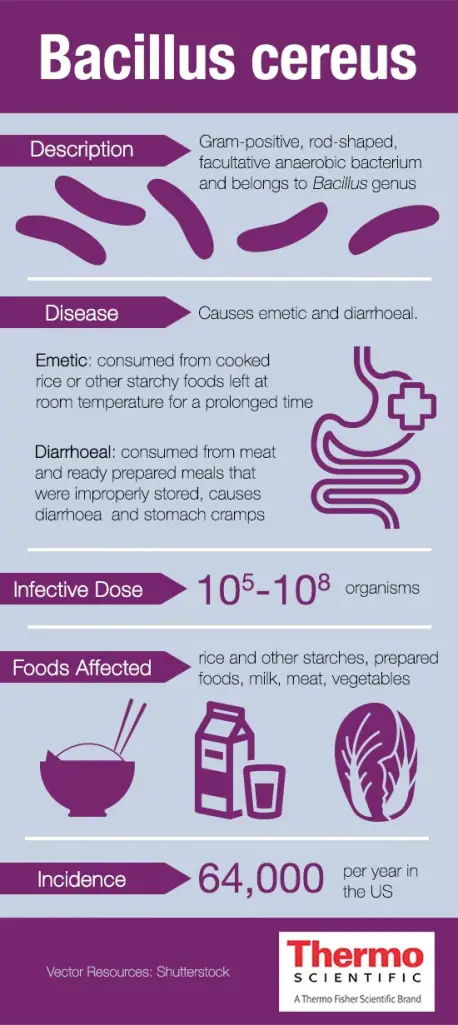Next week, on June 25, is an important Chinese-based cultural occasion, known as 端午节, or in English as the Dragon Boat Festival or Rice Dumpling Festival. It falls on the fifth day of the fifth lunar month, and is celebrated annually. What has this got to do with food microbiology you may be thinking … well, one of the main and most important traditions associated with this festival is eating 粽子 (Figure 1), known in English as rice dumplings, hence one of the English names for 端午 being Rice Dumpling Festival. Rice is to be considered as much of a food safety hazard as meat is, because of the potential for contamination with vegetative cells of spore forming Gram positive bacteria, spore germination and growth , and the resulting intoxication. Thus, for those who follow a vegan or vegetarian diet, rice would be the number one food safety concern. Let us explore this food safety concern (how it occurs, why it occurs and more) and how you can stay safe this Rice Dumpling Festival.
Rice dumplings are a sticky, glutinous rice snack also containing some meat or vegetables. While the meat component has its own food safety risks, in this blog article I wanted to focus on rice safety, since these are a rice-based food item. From personal observation, a concerning aspect of the handling of rice dumplings during storage and distribution is the temperature abuse they are subject to. For example, Eastern Rice Dumpling, a Singapore-located rice dumpling manufacturer states on their website (http://dongyuan.com.sg/index.php?route=news/article&news_id=10) “…when dumplings are placed in the refrigerator within 24 hours purchase, they can be kept for up to five days”. So, what temperature are they kept at during that first 24 hours? At ambient temperature, in Singapore’s tropical heat? I cringe when thinking what the assumed storage temperature is during this period!
So, here’s the what and how of why rice dumplings, or indeed any rice dish (Mortimer et al., 1974), is a foodborne disease hazard. Uncooked rice may contain spores of Bacillus cereus (Figure 2). This is a Gram positive, spore-forming, facultative anaerobic rod shaped bacterium (Figure 3) that is not uncommon in the environment and food. Once the rice has been cooked, the spores may germinate. If there are indeed spores present, and they have germinated, they longer the rice dish remains in the temperature danger zone (between 5 °C / 40 °F and 60 °C / 140 °F), the greater the chance the spores will germinate and the vegetative cells will grow to dangerous levels. If they do, they will produce an emetic toxin (called cereulide), such that a vomiting-based intoxication can result. Production of this toxin has been shown to take place at a temperature no lower than 15 °C (Finlay et al., 2002), which could be considered under temperature abuse considerations. This means that if the food is held below 15 °C, the bacteria will grow, but not produce toxin, thus an emetic intoxication will not result. Other type of foodborne disease could occur, but it is unlikely to be emetic. Granum and Lund (1997) have compiled a nice table summarising this disease – ingestion of the performed peptide ring toxin in food can result in vomiting, nausea and malaise within a half hour to five hours after ingestion, with the symptoms lasting for between six and 24 hours. In addition to rice, they state that pasta, pastries and noodles may also be implicated foods.
How can you protect yourself and your loved ones from this emetic intoxication? The Centre for Food Safety in Hong Kong (https://www.cfs.gov.hk/english/whatsnew/whatsnew_sfst/whatsnew_sfst_tips_for_enjoying_glutinous_rice_dumplings_safely.html) has some tips which are spot on for minimising your chance of succumbing to a foodborne disease episode. They are:
Buy glutinous rice dumplings from reliable retail outlets and don’t patronise illegal hawkers*.
Choose rice dumplings that are securely wrapped in wrapping leaves.
Store the rice dumplings in the refrigerator at or below 4 °C.
Consume the purchased rice dumplings as soon as possible and avoid prolonged storage.
Reheat the rice dumplings thoroughly for at least 15 minutes with the centre temperature at 75 °C before consumption.
Discard all leftover rice dumplings if they have been left at room temperature for more than two hours.
* In Australia, or indeed any country, this would also mean, do not buy rice dumplings from people making them at home, unless you can be sure they are making them in a council approved commercial kitchen. Retail outlets are the best option, as rice dumplings manufactured in such an environment are almost certain to pass all chemical and microbiological safety tests, as this survey in Hong Kong demonstrated in 2013 (https://hongkongbusiness.hk/food-beverage/more-news/rice-dumplings-pass-food-safety-tests?page=5&utm_source=reasonable&utm_medium=edm&utm_campaign=%5BCAMPAIGN_NAME%5D). If you are purchasing from a non-retail outlet, ask the person making or selling them to show you verification of the council’s approval of their preparation and manufacturing space. This is especially important during this COVID-19 pandemic period when illegal sellers of homemade food have proliferated. These people are unlikely to have the appropriate level of knowledge to minimise or eliminate food safety risks, because if they did, they wouldn’t be selling food prepared and manufactured in a non-approved space. Play it safe, and don’t put you and your loved ones at risk of this intoxication illness.
The points above are key to a safe and healthy Rice Dumpling Festival. Please heed and enjoy!
Reference
Finlay, W. J. J., Logan, N. A., & Sutherland, A. D. (2002). Bacillus cereus emetic toxin production in cooked rice. Food Microbiology, 19(5), 431-439.
Mortimer, P. R., & McCann, G. (1974). Food-poisoning episodes associated with Bacillus cereus in fried rice. The Lancet, 303(7865), 1043-1045.
Per Einar Granum, Terje Lund, Bacillus cereus and its food poisoning toxins, FEMS Microbiology Letters, Volume 157, Issue 2, December 1997, Pages 223–228, https://doi.org/10.1111/j.1574-6968.1997.tb12776.x




